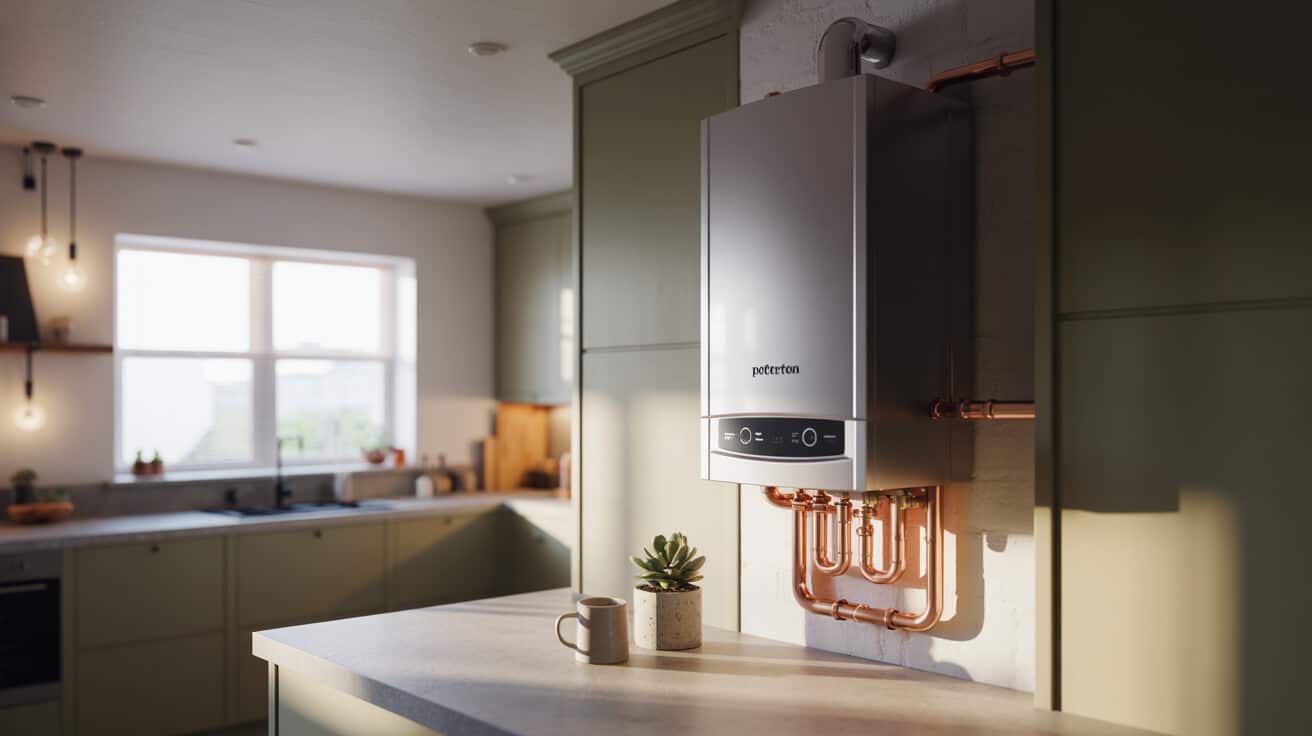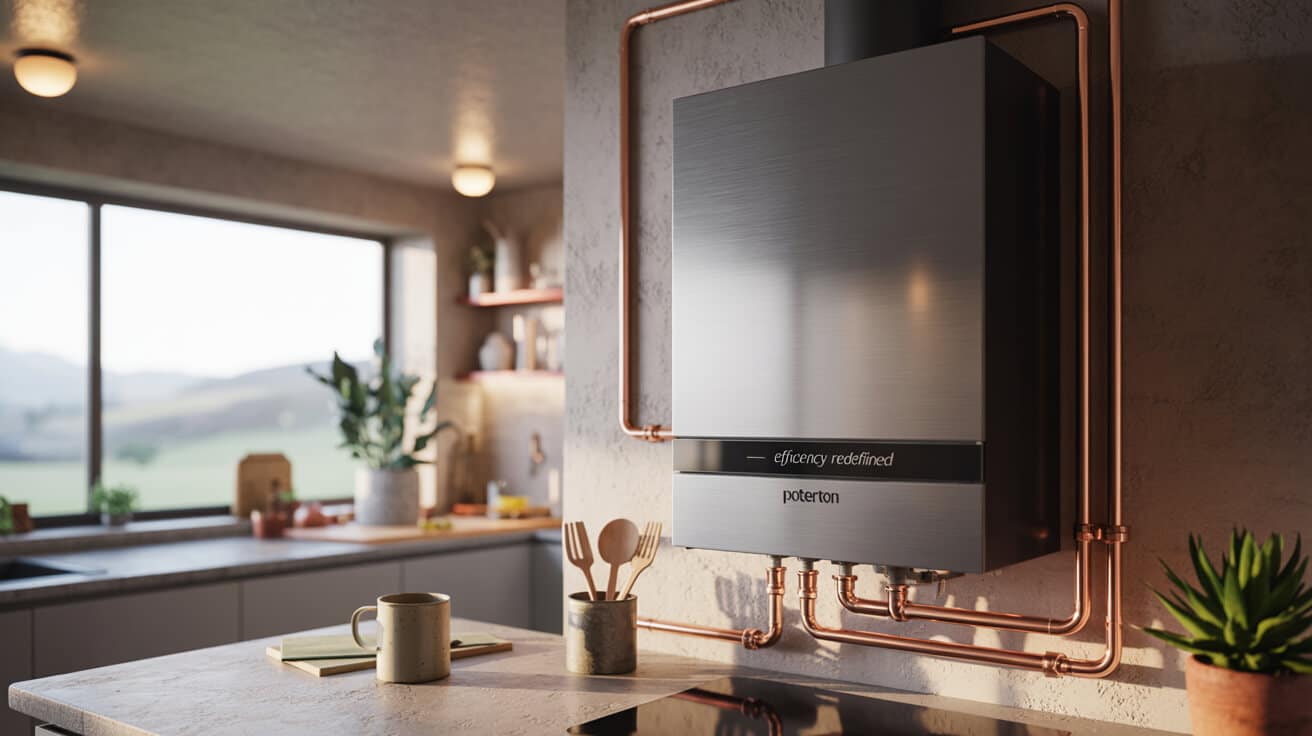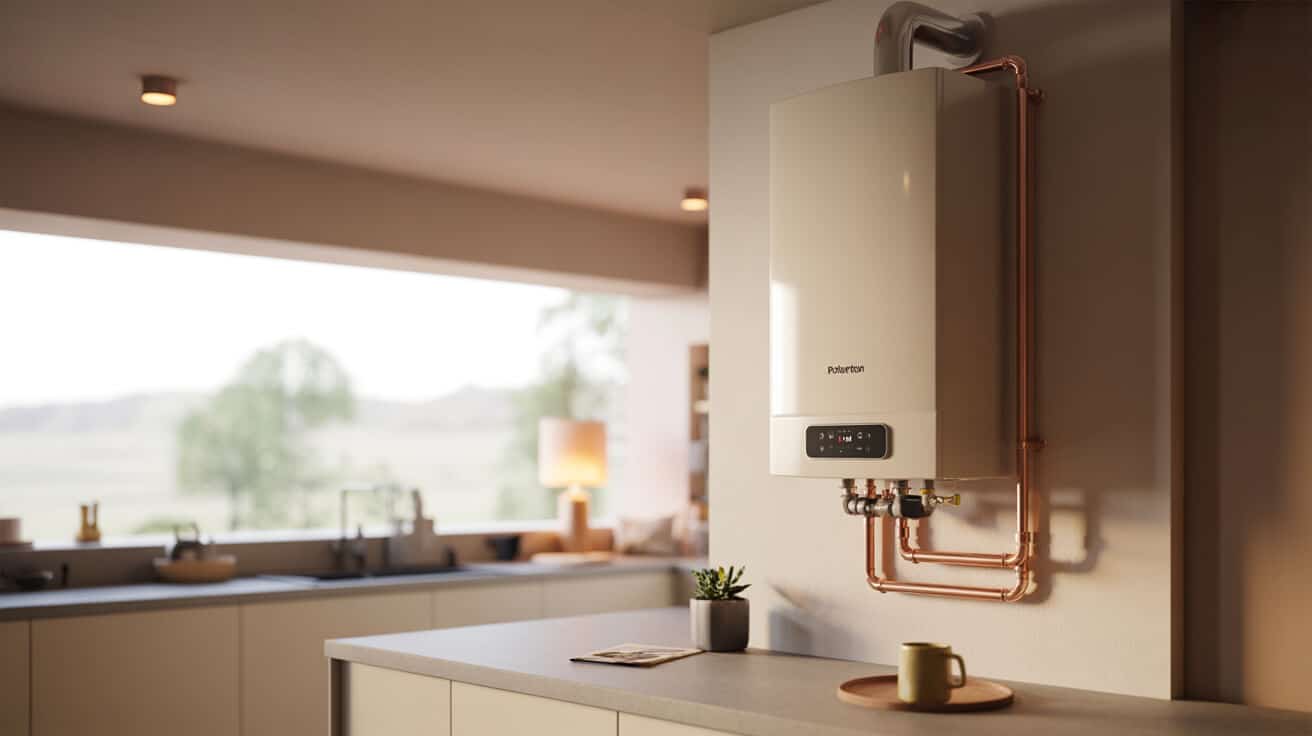Lead
Serving as a central point in the evolution of modern UK heating, the Assure Combi range merges high-efficiency heating and on-demand hot water through direct connection to the mains water supply. The design reflects a convergence of engineering reliability, accessible controls, and robust compliance frameworks. Used extensively by landlords, homeowners, and facilities directors, its versatility demonstrates how contemporary boiler technology adapts to your property’s ongoing needs while aligning with regulatory standards and sustainability goals.
Etymology or name origin
The label “combi”—short for “combination boiler”—signifies the device’s capacity to supply both central heating and instantaneous hot water from a single compact unit, without the requirement for separate water cylinders or storage tanks. “Potterton” denotes a heritage British manufacturer established in the late 19th century, specialising in domestic and commercial heating innovation and now operating under the Baxi Heating UK portfolio.
Overview and context
The Potterton Assure Combi occupies a pivotal niche within the United Kingdom’s heating and plumbing landscape, offering a solution tailored to high-density housing, property management portfolios, new builds, and refurbishment projects. Its operational context is shaped by tightening energy standards, tenant expectations, and lifecycle cost optimization—key considerations for landlords and property managers overseeing rental or multi-occupancy properties. The Assure range is often specified in social housing, professional property portfolios, and for asset upgrades where regulatory compliance and continuity of service are paramount. Your organisation benefits from simplified compliance, rapid installation cycles, and future-ready design when choosing modern combi systems.

History
Origins
Combination boilers began their ascent in the UK in response to urbanisation and shrinking property footprints, with engineers recognising the inefficiency of traditional cylinder-based systems. Potterton responded by transitioning from cast-iron boilers to wall-hung units, leveraging emergent condensing and modulation technologies. The company’s early embrace of system integration set the stage for next-generation combi appliances.
Industrial emergence
Throughout the late 20th and early 21st centuries, regulatory changes such as the Building Regulations Part L for energy efficiency and the introduction of the ErP (Energy-related Products) Directive accelerated the replacement of older models with condensing, combination designs. As a result, the Assure series emerged as a core offering, featuring innovations in heat exchanger materials, digital commissioning, and modularized component replacement.
Contemporary evolution
Successive redesigns of the Assure Combi incorporate improved burner modulation, higher seasonal efficiency ratings, and compatibility with smart controls. Expanded capacity options and enhanced service access have cemented its role within typical property upgrades, facilitating compliance for both new and existing buildings. Ongoing advances in digital diagnostics and service scheduling have further optimised asset management for property stakeholders.
Concept and description
Engineering principles
The Assure Combi utilises a condensing heat exchanger to maximise energy extraction from flue gases, yielding higher operational efficiency compared to non-condensing models. Integrated controls coordinate combustion, flow, and temperature via advanced algorithms that adjust output in response to varying thermal and instant hot water demands. The simultaneous elimination of storage tanks and improvement of mains-pressure hot water delivery allows the system to maintain compactness and high reliability.
System elements
Key components include:
- A fully modulating gas burner enabling precise energy input modulation;
- A stainless steel or aluminium primary heat exchanger designed for corrosion resistance and rapid thermal conductivity;
- A plate heat exchanger providing instantaneous hot water delivery;
- An expansion vessel, pressure relief valve, and condensate trap forming the core hydraulic and safety features;
- A pump with integrated air-vent for circuit circulation and self-regulation;
- Digital control interfaces and standardised connections compatible with mechanical, digital, or programmable thermostats.
Serviceability
The modular construction allows for quick replacement of high-wear parts, minimising downtime and operational inconvenience. An accessible front interface presents error codes and performance data, streamlining fault diagnosis and annual service routines. Right from installation, your organisation can benefit from a simplified commissioning process and reduced life-cycle maintenance risk.
Functionality, purpose, and applications
The Potterton Assure Combi is engineered to provide both rapid-response domestic hot water and efficient space heating, automatically prioritising demand as per user behaviour and property occupancy patterns. This ability to adapt output ensures that whether the requirement is a multi-bathroom morning surge or low-load central heating, water and heat delivery remain responsive to your evolving needs.
Applications
- Apartments, flats, and townhouses lacking cylinder space;
- Light commercial buildings, offices, and amenity blocks with moderate DHW demand;
- Social housing and council properties where compliance and maintenance traceability are legally required;
- Retrofit projects aiming to raise Energy Performance Certificate (EPC) scores;
- Owner-occupied houses seeking reliable service, energy savings, and future-proofing.
Control and interaction
The system’s controls accommodate a spectrum of user profiles, enabling both manual scheduling and programmable, app-enabled management—facilitating easy alignment with your organisation’s preferred control paradigms or your own daily schedules.
Classifications, types, and variants
Output variants
The Assure Combi series is available in several distinct capacities:
- 25 kW: ideal for smaller households or flats with limited DHW outlets;
- 30 kW: suited for average family homes with two bathrooms;
- 36 kW: best for larger properties with high, simultaneous hot water demand.
Each variant specifies a unique maximum DHW flow rate, system pressure range, and integration profile for zone or underfloor heating. Output classification enables property managers and installers to match a boiler precisely to your property’s size and domestic hot water requirements.
Related models and product family
- Assure System: for closed-loop heating with an unvented cylinder;
- Assure Heat: for conventional open-vented systems;
- Assure Gold/Platinum: offering extended warranty or advanced diagnostics.
Table: Assure Combi Variant Comparison
| Variant | Output (kW) | Max DHW Flow (l/min) | Usage Scenario |
|---|---|---|---|
| 25 | 25 | 10.2 | Flats/small homes |
| 30 | 30 | 12.2 | Family homes |
| 36 | 36 | 15 | Large/high demand |

Systems, tools, and installation methodologies
Professional installation
Legislation requires that all Assure Combi installations be undertaken by a Gas Safe Registered engineer. The commissioning process retains legal and warranty implications, mandating full completion of the manufacturer’s Benchmark logbook.
Essential tools and materials
Installers rely on:
- Pipework tools for copper and plastic (press-fit, solder, push-fit);
- Electrical testers and digital multimeters;
- Flue gas analyzers for combustion and tuning;
- System flush kits for removing legacy debris;
- Magnetic philtres to protect your heating circuit.
Installation and commissioning process
- Pre-site survey: assesses property suitability, flue route, pressure, and ventilation.
- Mounting and fixing: coordinates positioning with access panels and safety clearance.
- Hydraulic integration: connects to mains supply, heating circuit, and drainage.
- Electrical wiring: ensures control and safety circuits are live and earthed.
- Filling and testing: hydraulic flushing, filling with inhibitor, air purge, and leak checks.
- Flue assembly and verification: proper terminal positioning and weather sealing.
- Final checks and commissioning: combustion tuning, control sync, system demonstration, paperwork.
Maintenance protocols
- annual servicing: including burner inspection, heat exchanger clean, safety checks, and flue integrity test.
- Philtre and inhibitor top-up: maintains performance and longevity.
- Digital check-up: error code diagnostics and control recalibration.
Stakeholders and professional roles
Manufacturer and supply chain
Potterton (and Baxi Heating UK) oversees research, product engineering, and distribution to merchants and authorised installers. Major merchant networks expedite access to equipment and spares.
Installation and maintenance providers
Providers such as Plumbers 4U deliver Gas Safe-certified installation, regulatory documentation, and responsive aftercare. Your organisation benefits from explicit service records, transparent process documentation, and rapid response to emergent issues through professional service partners.
Asset holders and users
- Landlords: and letting agents: Responsible for annual inspection, maintenance, and compliance paperwork.
- Homeowners: Direct stewardship of commissioning, operation, and service scheduling.
- Property managers and FM directors: Oversight of portfolio-wide upgrades, maintenance cycles, and regulatory risk mitigation.
Building control officers, Gas Safe Register, and local authority housing enforcement perform audits, approve installations, and ensure adherence to national standards.
Legal, regulatory, and ethical considerations
Installation law
Every gas appliance must be fitted and signed off by a qualified Gas Safe Registered engineer, with documentation typically confirmed via the benchmark logbook. Both property owners and agents are responsible for regulatory compliance at point of sale, let, or modification.
Landlord and agent duties
Landlords are required by statute to carry out annual Gas Safety Checks (CP12) on all gas appliances in tenanted properties and provide documentation to tenants. Failure to comply may result in penalties or legal action and can invalidate insurance and warranty. By integrating services with reputable partners like Plumbers 4U, your duty-of-care and documentation requirements are streamlined.
Emissions and environmental requirements
All models meet or exceed ErP (Energy-related Products Directive) standards for seasonal efficiency and NOx emission limits. Water treatment and inhibitor protocols are mandatory for maintaining warranty and component longevity; failure to observe may lead to rapid appliance deterioration.
Ethical framework
Professional standards obligate prompt, clear communication of risk or issues found during services and repairs, with a strong emphasis on health and safety for all property types.
Performance metrics, technical data, and measurements
System performance
- Seasonal efficiency: typically 93–94% (ErP ‘A’ rating).
- DHW flow rates: up to 15 litres per minute (36 kW model).
- Output modulation: Minimum firing rate down to 20–30% of maximum, minimising cycling and energy waste.
Technical table: Key Specifications
| Feature | Typical Value (30kW model) |
|---|---|
| Seasonal efficiency | 93% (ErP) |
| DHW flow rate | 12.2 l/min |
| Max system pressure | 3 bar |
| Flue length (max) | 20 m concentric |
| Weight | 29–34 kg (depending on model) |
| Noise emission | 47–51 dB(A) |
| Boiler class | Condensing |
Diagnostic integration
- Onboard diagnostics: digital display with error/fault codes.
- Remote control: Compatible with smart controls for performance monitoring.
- Benchmark-compliant data for audit or resale documentation.
Challenges, barriers, and limitations
Operational and technical barriers
- Harsh water chemistry (limescale, sludge) reduces system lifespan and efficiency.
- Incomplete hydraulic cleansing during retrofit can leave legacy debris that accelerates wear or blocks plate heat exchangers.
- Flue routing or condensate pipe freezing may restrict installation in some properties.
Social and economic factors
- Accountability for periodic service and documentation requires robust property management processes and knowledgeable partners like Plumbers 4U.
- Tightening emissions and performance regulations may shorten the usable lifecycle of installed assets, influencing investment cycles and cost-of-ownership models.
Integration and system compatibility
- Smart home control integration may be limited by existing property wiring or incompatible proprietary systems.
- High hot water demand properties (multi-bathroom, commercial kitchens) may exceed combi output, necessitating alternative solutions.
Table: Common Error Codes
| Code | Issue Detected | Recommended Response |
|---|---|---|
| E119 | Low pressure | Top up system, check leaks |
| E133 | Ignition fault | Reset, check gas and spark |
| E110 | Overheat lockout | Allow to cool, check flow |
| E160 | Fan error | Engineer service |
Impact, influence, and legacy
the adoption of combi boilers, including the Assure series, fundamentally altered UK residential and light commercial heating footprint by delivering compact, high-efficiency, and direct-supply hot water and central heating. Regulatory frameworks adopted these advances, mandating their use in new builds and incentivizing upgrades across property portfolios. The collaborative approach between manufacturers, service providers like Plumbers 4U, and property asset holders established best practice documenting, maintenance, and user training routines that continue to shape industry standards. This transformative legacy yields greater warmth, reliability, and compliance for your properties while reducing long-term cost and risk.
Future directions, cultural relevance, and design discourse
Upcoming policy and design trajectories emphasise further decarbonization of property portfolios, potential transition to hydrogen-ready or hybrid heat pump-combi formats, and the expansion of remote monitoring for predictive maintenance. Shifting cultural expectations highlight the value of visible compliance, proactive service partnerships, and whole-building sustainability. Within this evolving discourse, your organisation can anticipate not only technical updates but also changing expectations of tenant comfort, asset stewardship, and lifecycle management—making the correct selection of a heating system, and engagement with trusted service partners, ever more significant to future success and resilience.

